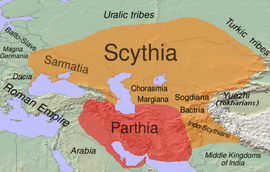And the day before, on Wednesday I had a different encounter, with a younger woman from Community Organisers. She listened, I spoke.
Two completely different and unexpected encounters. Both made me feel good, however surprising may it sound.
...
This Friday, going along Ken Church Street again and as always, looking at the shop windows and into the shops through the said windows, I noticed a portrait of a beautiful woman. I stopped to look and then saw a portrait of a man in an Oriental attire which reminded me of the Polish Sarmatians. Instead of explaining it to you, Dear Inquisitive Reader, I shall refer you to an entry on Sarmatism in Wikipedia as it makes a rather informative and interesting read.
However, I decided to add few bits here:
'The term Sarmatism was first used by Jan Długosz in his 15th century work on the history of Poland.[5] Długosz was also responsible for linking the Sarmatians to the prehistory of Poland and this idea was continued by other chroniclers and historians such as Marcin Bielski,Marcin Kromer, and Maciej Miechowita.[5] Miechowita's Tractatus de Duabus Sarmatiis became influential abroad, where for some time it was one of the most widely used reference works on the Polish-Lithuanian Commonwealth.[5]
The presumed ancestors of the szlachta, the Sarmatians, were a confederacy of predominantly Iranian tribes living north of the Black Sea. In the 5th century BC Herodotus wrote that these tribes were descendants of the Scythians and Amazons. The Sarmatians were infiltrated by the Goths and others in the 2nd century AD, and may have had some strong and direct links to Poland. Yet such issues are not simple.[6] The legend stuck and grew until most of those within the Commonwealth, and many abroad, believed that many Polish nobles were somehow descendants of the Sarmatians (Sauromates).[5]Another tradition came to surmise that the Sarmatians themselves were descended from Japheth, son of Noah.[7]
Some holding to Sarmatism tended to believe that as medieval Polish nobility they were the descendents of the ancient Sarmatian people.
(...).
Centuries later modern scholarship discovered evidence showing that the Alans, a late Sarmatian people speaking an Iranian idiom, did invade Slavic tribes in Eastern Europe before the sixth century, and that these "Sarmatians evidently formed the area's ruling class, which was gradually Slavicized."[9] Their direct political connection to Poland, however, would remain somewhat uncertain.[10] In his 1970 publicationThe Sarmatians (in the series "Ancient Peoples and Places") Tadeusz Sulimirski (1898–1983), a Polish-British historian, archaeologist, and researcher on the ancient Sarmatians, discusses the abundant evidence of the ancient Sarmatian presence in Eastern Europe, e.g., the finds of various grave goods such as pottery, weapons, and jewelry. Possible ethnological and social influences on the Polish szlachta would include tamga-inspired heraldry, social organization, military practices, and burial customs.
....
OK, having read this, you deserve to see the pictures. I was allowed to publish them here.
Here is the most unique portrait of an Indian princess painted by an English artist in the first half of the 19th century, as I was told by a knowledgeable young woman at the gallery.
Facing the princess on the gallery wall was an Indian Maharaja who prompted me to mention the Polish Sarmatism. If you ever wander to a Polish city of Kielce, between Warsaw and Krakow), do go to the Palace of The Krakow Bishops and see the Sarmatian portraits on permanent display there. If you cannot go, or are curious now, click here to see one picture I found online.
At the same gallery there was a contemporary artwork that was simply dragging you to it. Look closely:
It was created by a female artist who lives and works in Teheran. She is a calligrapher of an amazing talent, don't you think so?
Should you wish to see the pictures or learn more about them, the artists and the gallery, look for Amir Mohtashemi and enjoy!
Good night!




No comments:
Post a Comment